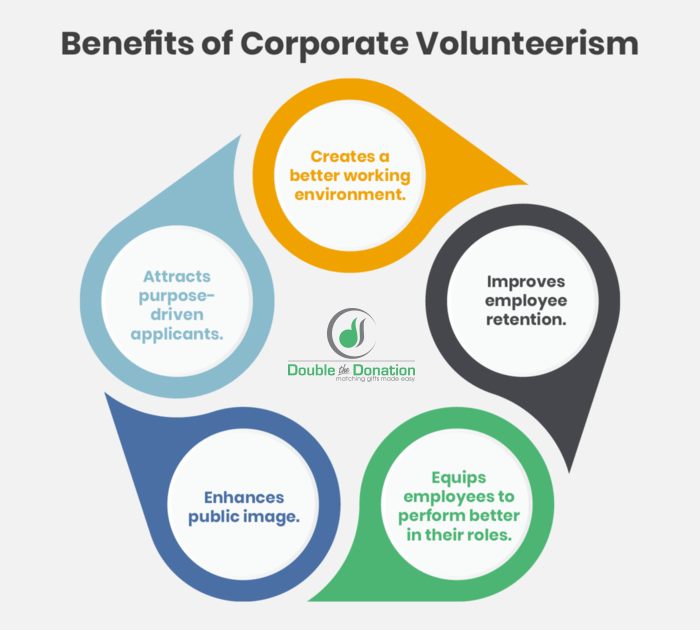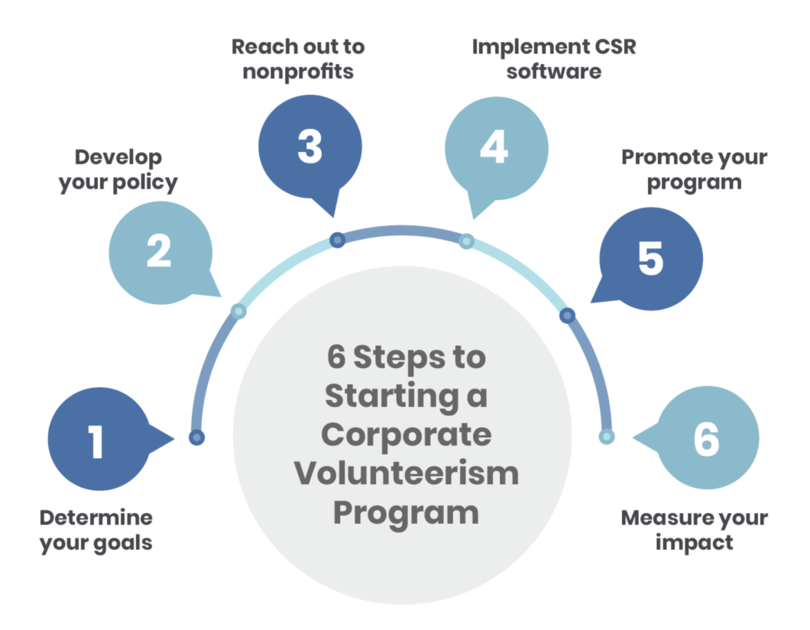Corporate Volunteerism | What Nonprofits Should Know
The companies that stand out to customers, employees, and communities alike are those that are committed to bettering the world around them. When companies practice corporate social responsibility (CSR), they use their power and funds to take actions that improve society—including through corporate volunteerism.
This presents a way for employees to work together for the greater good and support charitable causes. With about 63 million Americans volunteering each year, corporate involvement can inspire more people in the workplace to join their peers in contributing their time.
As a nonprofit, understanding the ins and outs of corporate volunteer programs will allow your team to target the opportunities more effectively than ever. That’s why, in this guide, we’ll answer your frequently asked questions—such as:
- What Is Corporate Volunteerism?
- What Are the Benefits of Corporate Volunteerism?
- How Do Corporate Volunteerism Programs Work?
- How Can Companies Start Corporate Volunteerism Programs?
- What Are Examples of Companies with Corporate Volunteerism Programs?
Whether your organization already boasts a standout volunteer program or you’re looking for new ways to garner corporate support, these tips and insights are designed to take your efforts to the next level. Let’s begin!
What Is Corporate Volunteerism?
Corporate volunteerism refers to a company’s initiative that encourages and supports its employees in volunteering their time and skills to help nonprofit organizations, charitable causes, or community projects.
While there are a lot of different programs that may fall under this umbrella, we recommend organizations become familiar with these leading forms:
- Volunteer grants — Companies make financial donations to nonprofits based on the number of hours employees volunteer.
- Volunteer time off — Companies provide paid leave for employees to volunteer during working hours.
- Skills-based volunteerism — Employees use their professional skills, such as marketing, IT, or finance, to help nonprofits address specific needs.
- Team volunteer events — Organized group activities that allow employees to work together on community service projects.
What Are the Benefits of Corporate Volunteerism?
It’s clear that nonprofits benefit from corporate volunteer programs by gaining more helping hands. However, you may be wondering why companies choose to get involved. And that’s simple—it’s good for their bottom lines!

For companies, creating a corporate volunteerism program:
- Creates a better working environment. When people work together outside of the workplace, it improves team cohesion and performance in the workplace. Take it from the 64% of employees who claim that volunteering with coworkers has strengthened their work relationships. Additionally, 70% of employees think corporate volunteerism is a more effective morale booster than other company-sponsored activities like happy hours.
- Improves employee retention. Employees who feel empowered by their employer to contribute to worthy causes are more likely to stick around. The United Way British Columbia Social Purpose Institute reports that employees who work for purpose-driven companies have 20% longer expected tenures and 64% higher levels of job fulfillment.
- Equips employees to perform better in their roles. Volunteering doesn’t just help those in need. It also benefits the volunteers themselves. After returning from a volunteering experience, employees may take a new perspective on their work as a result of the relationships they’ve formed or skills they’ve honed. Studies also show that volunteerism leads to significant mental and physical health benefits, which can improve job performance.
- Enhances public image. These days, people expect more from companies than their product or service offerings. With 77% of customers looking to purchase from companies that contribute to the greater good, businesses need to exemplify their company values with real action. Promoting your volunteerism efforts on social media and your website proves to consumers that your company works to make the world a better place.
- Attracts purpose-driven applicants. Not only do customers want to purchase from purpose-driven companies, but they want to work at them, too! PWC reports that 65% of people want to work for a company with strong CSR initiatives in place. To attract these applicants, your company should form a strong CSR program that puts corporate volunteerism at the forefront.
Meanwhile, for nonprofits, getting involved with corporate volunteerism:
- Increased Volunteer Capacity. Corporate volunteering brings groups of employees to participate in nonprofit initiatives, providing a significant boost in manpower. Whether it’s for one-time events like community cleanups or ongoing projects such as mentoring programs, corporate volunteers help nonprofits achieve more.
- Access to Skilled Volunteers. Corporate volunteer programs often involve employees with specialized skills in areas like marketing, finance, IT, and project management. This access to professional expertise allows nonprofits to accomplish tasks that might otherwise be outside their budget.
- Long-Term Corporate Partnerships. By engaging corporate volunteers, nonprofits can build long-term relationships with companies. These relationships often evolve beyond just volunteerism to include financial donations, sponsorships, and in-kind contributions, too!
- Enhanced Visibility and Credibility. When companies promote their volunteer efforts, nonprofits benefit from increased visibility. This can significantly raise the profile of the nonprofit, attracting attention from other potential donors, volunteers, and corporate partners. Being associated with reputable companies also boosts the nonprofit’s credibility, making it easier to attract future support from both individuals and organizations.
- Stronger Community Impact. With the help of corporate volunteers, nonprofits are able to increase their impact within the community. The additional resources and workforce help nonprofits serve more people, deliver better services, and extend their reach into underserved areas.

In summary, when companies implement CSR initiatives such as corporate volunteerism, their employees, customers, nonprofit partners, and community benefit from their generosity and commitment to the greater good.

How Do Corporate Volunteerism Programs Work?
Each volunteerism program works differently, largely depending on the company’s policy. Here are a few types of volunteerism you can target with your efforts:
- Direct service volunteering. Volunteers work directly with nonprofit beneficiaries in their communities. For example, serving meals to the homeless.
- Team volunteering. Groups of volunteers can help expedite large tasks or projects, and corporate groups are often perfect for the job. In the process of volunteering together, employees forge stronger relationships, too.
- Mentorship. Employees mentor organizational beneficiaries to teach them life or professional skills. This type of volunteering is common for organizations that serve youth, such as Big Brothers Big Sisters of America, which seeks volunteer mentors for children with military families or incarcerated parents.
- Employee internships. Some companies host employee internships where they will continue to pay an employee’s salary while the employee donates their time and expertise to a nonprofit. For instance, the Orange County United Way’s Loaned Executive Program encourages businesses in the area to lend their employees to help the organization carry out its mission. In return, United Way publicizes the company’s contributions to social good.
All in all, corporate volunteer programs offer diverse opportunities for companies and their employees to engage with nonprofits, each tailored to different needs and goals.
Regardless of their setup, these programs provide valuable support to nonprofits while fostering stronger relationships among employees and enhancing a company’s commitment to social good. By understanding the various types of volunteerism programs, nonprofits can strategically target corporate partners and tap into the full potential of corporate volunteer support, ultimately driving greater impact in their communities.
How Can Companies Start Corporate Volunteerism Programs?
Tons of companies already offer standout volunteer programs—but new initiatives are being rolled out every day, too. As a nonprofit, understanding the steps companies take to implement new volunteerism efforts can go a long way. This allows you to better understand your corporate partners, advocate for new programs, and more. And we’ll cover that process here!

1. Determine goals.
Any new project or initiative starts with goal setting to contextualize the efforts. In this case, companies should create volunteer-related goals that align with the SMART framework:
- Specific (S): All goals should be clearly defined. Instead of a vague goal like “start a company volunteer program,” try a specific objective, such as “launch a company-wide volunteer program focused on environmental conservation.”
- Measurable (M): Goals should be quantifiable, allowing teams to track their progress overall. For example, a goal like “recruit 50 employees to participate in volunteer activities during the first quarter” is well-positioned to measure success later on.
- Achievable (A): Goals should be realistic and align with available resources, time, and capacity. Setting an unrealistically lofty goal can lead to frustration when teams ultimately fall short.
- Relevant (R): Goals should reflect the company’s mission, values, and broader objectives. They should align with the company’s general CSR strategy and objectives, too.
- Time-bound (T): Goals should have a specific timeframe for completion. For example, “launch the volunteer program by the end of the third quarter” sets a clear and understandable deadline.
Put all these elements together, and the goal-setter has a clear, measurable objective its team can likely achieve in the given timeframe. An example of a SMART corporate volunteer program goal may be to provide 5,000 community service hours to sustainability-oriented organizations in a single calendar year.
2. Develop a policy.
Next, a company will decide which types of volunteering the program will offer, along with any accompanying program guidelines. For instance, let’s say a program includes volunteer grants. In this case, the company will need to determine:
- How much the company will donate for every volunteer hour tracked by its employees
- Which types of nonprofits are eligible for volunteer grants
- Employee eligibility requirements (e.g., full-time, part-time, and retired employees)
- Deadlines for submitting a volunteer grant request (e.g., one year after the volunteer activity)
For the best results, teams should summarize the entire corporate volunteerism program in a singular document that employees can refer to if they have any questions about getting involved. After all, having clear guidelines is much more likely to encourage participation.
3. Reach out to nonprofits.
To secure volunteer opportunities for a company’s employees, it can reach out to nonprofits that align with the company’s values. It can be especially powerful for employers to form partnerships with local organizations and have their teams volunteer with them regularly.
A company may even survey employees using its employee engagement platform to see which causes they already volunteer with—and to guide the company’s outreach. Employers should ask questions about which nonprofits or causes employees would like to support, and they’ll be much more likely to participate in the volunteer program once it’s launched!
4. Implement CSR software.
To streamline operations, companies can keep their corporate volunteerism program and opportunities organized with CSR software.
Participating employers are encouraged to look for a platform with volunteer management tools and features that will allow them to:
- Centralize and promote volunteer opportunities
- Track volunteer hours
- Submit volunteer grant requests
The best CSR software providers also simplify the engagement process for employees by integrating with auto-submission tools that submit corporate giving requests on employees’ behalf.
5. Promote the program.
In order to drive participation among employees, companies should promote their corporate volunteer programs to their staff so they can start participating. Corporate leaders may set up a company-wide meeting to go over the program’s policy and answer any questions. They should also provide training for any CSR software, so all employees can use it effectively.
After the initial launch, employers want to be sure to remind employees about the program regularly and frequently. This can even include business-organized corporate volunteer days to inspire participation!
6. Measure impact.
One of the main motivations for launching a corporate volunteer program is to impact the causes a company supports, so participating employers want to be able to measure results. Plus, companies can report on their impact to let stakeholders know how well the efforts are panning out.
With the help of a CSR platform, it’s easy to keep track of important metrics such as:
- The number of volunteer hours recorded
- Which organizations a team has volunteered with
- The amount donated to nonprofits via volunteer grants
Companies can even survey their employees and participating nonprofits to illustrate how the program has impacted real lives. Then, they can use these insights to follow up on their initial goals.
What Are Examples of Companies with Corporate Volunteerism Programs?
As a nonprofit, it can be difficult to imagine what corporate volunteer opportunities are out there without a tangible example. For this reason, we’ve compiled a list of companies with successful corporate volunteer initiatives. Check them out below, and don’t forget to check if your supporters work for these employers!
Disney
Disney’s “VoluntEARS” contribute to a variety of charitable causes through their volunteer program. Their efforts include:
- Working with food banks to deliver food to those in need
- Filling backpacks with school supplies to donate to children in underserved communities
- Making blankets to donate to children’s hospitals and animal shelters
- Reviewing images for the Great Barrier Reef Project’s conservation efforts
- Recording Disney stories for children in rural areas to enjoy
- Saving Monarch butterflies with butterfly-friendly backyard habitats
Additionally, Disney offers skills-based volunteering and volunteer grant opportunities. Through their corporate volunteerism program, Disney employees have volunteered a total of 13 million hours since the program began in 1983.
CVS Health
CVS Health is committed to giving back through corporate volunteerism. From helping at food pantries to running fundraising events, CVS Health employees volunteered at a rate that CVS estimates to be worth over $2.5 million in 2021. Through CVS Health’s intranet, employees can track their volunteer hours and request volunteer grants.
The CVS Health Foundation even offers volunteer challenge grants ranging from $250 to $5,000 for nonprofits their employees volunteer with or fundraise for.
Kohl’s
The star of the Kohl’s Volunteer Program is its volunteer grants. For every volunteer hour an employee tracks, Kohl’s donates $25 to the associated nonprofit. While some companies set a minimum time commitment in order to be eligible for volunteer grants, Kohl’s only requires volunteers to have worked at least one hour.
Kohl’s also uses CSR software to organize volunteer opportunities for their employees. They encourage nonprofits to submit their volunteer opportunities and post them on the platform.
Final Thoughts and Additional Resources
If you’re looking to bolster your company’s CSR efforts, corporate volunteerism is a great place to start. When people come together in support of a common cause, they not only help those in need but also build teamwork and leadership skills they can bring with them to the office.
Companies that don’t have a corporate volunteerism program should begin by looking at the programs of other businesses for inspiration. It can also be helpful to read CSR resources, such as the ones linked below:
- Top 10 Volunteer Grant Companies: Increase Corporate Dollars. These companies represent the top providers of volunteer grants. Read more to shape how your business handles volunteer grants.
- Top Volunteer Time Off Companies | 35 Programs to Know. VTO is another key piece of the corporate volunteer puzzle. Explore leading companies offering these programs here.
- Free Download: Leveraging Corporate Volunteer Incentives. Find out how your team can make the most of corporate volunteer incentives like volunteer grants, VTO, and more.




